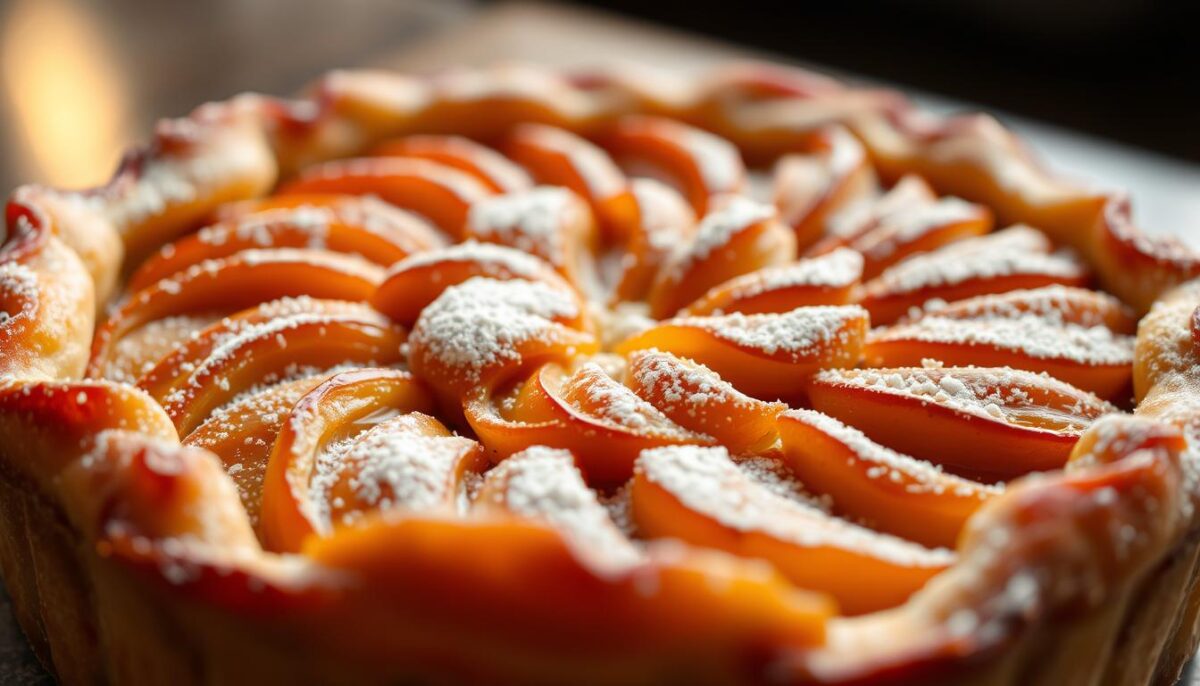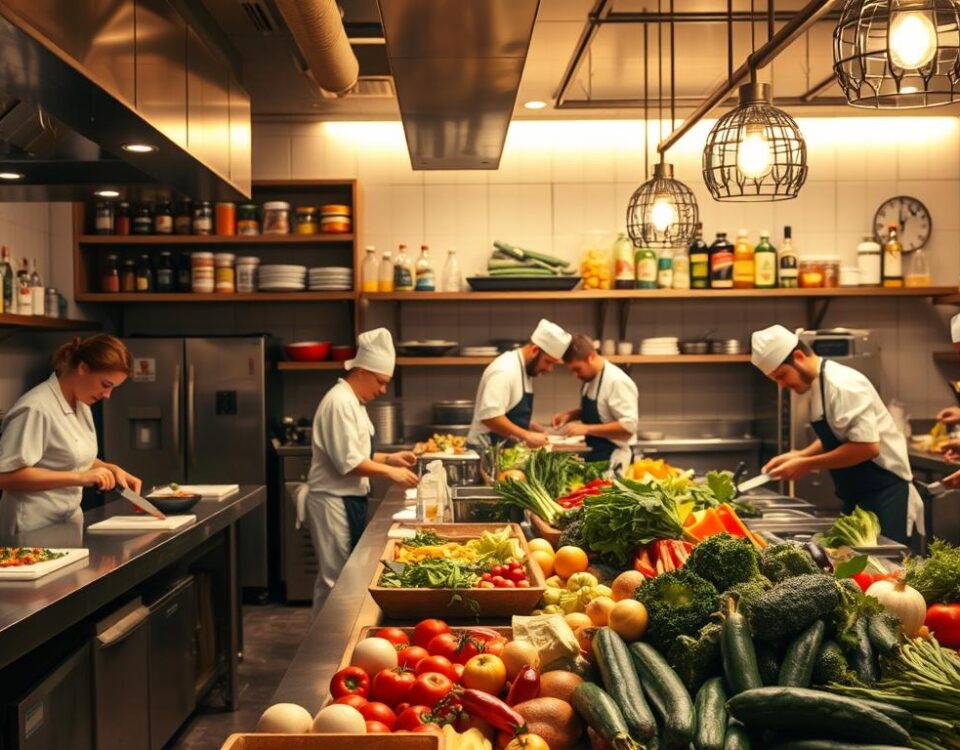
Taste of Turkey: How to Cook the Perfect Homemade Lahmacun
April 26, 2025
Mexican Street Food at Home: How to Make Tacos al Pastor
April 27, 2025I still remember the first time I tasted a buttery croissant in a tucked-away Parisian bakery. The flaky layers melted on my tongue, and suddenly, I understood why food is the heartbeat of France. It’s not just about ingredients—it’s about stories, tradition, and the quiet pride of generations.
That trip sparked my obsession with recreating these flavors at home. Over the years, I’ve learned that iconic meals aren’t just for fancy restaurants. With a little guidance, anyone can bring a slice of France to their kitchen—or plan a weekend adventure inspired by them.
In this guide, I’ll share dishes that made me fall in love with the country’s cuisine. You’ll find beloved staples and lesser-known treasures, each carrying the soul of their regions. Whether you’re hosting friends or simply treating yourself, these recipes promise to turn meals into memories.
Key Takeaways
- Discover why France’s culinary legacy continues to inspire global menus
- Learn how passion and simplicity define authentic cooking styles
- Find inspiration to recreate restaurant-quality meals at home
- Explore both iconic and under-the-radar regional specialties
- Get practical tips for planning a food-focused weekend getaway
Introduction to My French Culinary Journey
My obsession began with a steaming bowl of soupe au pistou in a Provençal farmhouse. The aroma of fresh basil and garlic slapped me awake – this wasn’t just lunch, but a masterclass in simplicity. That moment rewired how I thought about food forever.
My First Encounter with Authentic French Flavors
Winter escapes in the Alps taught me patience. I’d watch chefs turn humble ingredients like Comté cheese and cured meats into time-honored specialties. One baker shared his family’s tarte aux myrtilles recipe – handwritten in 1923! These weren’t just meals, but edible history lessons.
Summers in Bordeaux revealed another truth: great cooking needs great ingredients. I’d arrive at markets at dawn, watching vendors arrange plump tomatoes like artists. One farmer taught me his traditional French approach to selecting melons – smell, weight, and a secret thumb test.
Why French Cuisine Speaks to Me
What hooks me isn’t just the flavors, but the rituals. There’s magic in watching a grandmother shape dough for pissaladière, her hands moving with 70 years’ muscle memory. Each region’s recipe variations tell stories of wars, trade routes, and stubborn local pride.
Through recipe books and kitchen mishaps, I’ve learned that traditional French cooking isn’t about perfection. It’s about respecting ingredients while leaving room for joy. My signature ratatouille? Still evolving after 12 summers – and that’s exactly how it should be.
Setting the Scene: The Magic of French Food
Dawn light filters through wooden crates stacked with dewy vegetables at a Provençal market. This is where meals begin – not in kitchens, but among farmers weighing sun-ripened tomatoes and cheesemongers unwrapping wheels of butter-golden Camembert. Every basket tells a story of soil and seasons.
Where Flavor Takes Root
I learned early that exceptional food demands exceptional ingredients. A Normandy dairy farmer once showed me how grass-fed cows produce richer milk – the secret behind that iconic cheese crust. In Brittany, bakers revealed why sea-salted butter makes their croissants sing.
Markets teach you to shop like a pro. Squeeze peaches gently. Sniff melons where the stem was. Watch for vendors eating their own wares – that’s your quality guarantee. One grower taught me his rule: “If it doesn’t make you hungry, don’t sell it.”
Recreating these flavors starts at home. Seek out small-batch cheese aged on wooden boards. Use European-style butter with higher fat content. Let seasonal produce guide your menu. True magic happens when you treat ingredients as partners, not props.
That’s the heart of this food culture – respect for what the land provides. Whether you’re slicing a baguette or simmering stew, quality transforms everyday meals into something extraordinary.
Discovering a French Classic Dish Guide
The clatter of copper pots in a Lyon bistro kitchen stopped me mid-bite. Between sips of bold Burgundy wine, I realized something: mastering France’s culinary legacy starts with understanding its iconic recipes. Curating this collection felt like assembling a mosaic – each piece reveals part of a delicious, centuries-old story.
You’ll notice these time-honored recipes popping up everywhere from New York bistros to Tokyo bakeries. That’s the magic of french cuisine – it adapts while staying rooted in tradition. One Parisian chef once told me, “Our cooking isn’t about complexity. It’s about making ordinary ingredients sing.”
In the coming sections, we’ll explore everything from caramel-kissed tarts to soul-warming stews. Each dish earned its spot through history, flavor, and personal kitchen adventures. Did you know boeuf bourguignon evolved from peasant food to menu star? Or that proper cassoulet sparks friendly wars between villages?
This isn’t just a list – it’s a backstage pass to the techniques and stories behind the food. Whether you’re planning a themed dinner or simply curious, these recipes offer more than meals. They’re edible invitations to slow down, savor, and celebrate the art of cooking.
“The best dishes aren’t created – they’re inherited through generations of hungry hearts.”
Ready to transform your kitchen? Let’s dive into flavors that shaped a nation’s palate and continue inspiring menus worldwide. Trust me – your next Sunday supper just got an upgrade.
Tarte Tatin: The Iconic Upside-Down Dessert
The scent of caramelized apples and toasted pastry still transports me to a tiny Loire Valley kitchen. There, I learned that greatness often begins with mistakes. This inverted dessert proves culinary magic hides in simplicity – butter, fruit, and heat colliding into perfection.

The Accidental Creation That Became a Legend
In 1898, hotelier Stéphanie Tatin famously rescued a burnt apple pastry by flipping it onto a plate. Her “mistake” became an instant hit at Hotel Tatin. By the 1920s, Parisian chefs added it to their menus, cementing its status as a national treasure.
What began as a family recipe now graces tables worldwide. I’ve tasted versions from Tokyo patisseries to New York bistros – each honoring that buttery, fruit-forward soul. The secret? Letting apples caramelize until they’re sweet enough to balance the flaky crust.
Serving Suggestions for a Perfect Weekend Treat
Pair warm slices with vanilla crème anglaise or salted caramel ice cream. For brunch? Add a dollop of mascarpone and fresh thyme. My favorite twist: drizzle with dark honey and crushed pistachios.
| Occasion | Pairing | Pro Tip |
|---|---|---|
| Dinner Party | Crème fraîche | Serve in cast-iron skillet |
| Weekend Brunch | Sparkling cider | Use firm, tart apples |
| Casual Dessert | Vanilla bean ice cream | Add orange zest to caramel |
Don’t fear the flip! Even lopsided versions taste divine. As one baker told me, “Imperfections prove it’s homemade – and that’s where the love lives.”
Boeuf Bourguignon: A Rich, Red Wine Braise
The gentle bubble of a simmering pot still reminds me of my Burgundy host family’s kitchen. Their boeuf bourguignon taught me that great stew isn’t cooked – it’s coaxed into existence. This peasant-turned-royal recipe thrives on patience, turning tough cuts into velvet-soft revelations.
My first attempt? A watery disaster. I’d rushed the browning stage, skimping on that crucial fond – the caramelized bits that build depth. Now I sear beef chunks until they practically sing, deglazing with bold red wine to scrape up every flavor-packed speck.
The Art of Slow Cooking at Home
True boeuf bourguignon is a patient alchemy. Simmer pearl onions and mushrooms separately to preserve texture. Use wine you’d actually drink – that $8 bottle works better than “cooking wine” loaded with salt. My trick? Add a splash of cognac during the final simmer for aromatic lift.
Regional variations fascinate me. Some Burgundians swear by adding pig’s trotters for gelatinous richness. Others toss in orange zest. I’ve learned to embrace improvisation – subbing pancetta for lardons or using port when red wine runs out. The stew forgives, as long as you honor its slow-cooked soul.
Don’t rush it. Let flavors meld overnight – it’s even better reheated. Serve over buttery egg noodles or crusty bread to soak up that wine-kissed sauce. As my host mère once said, “Hunger makes the best seasoning.” Give this stew time, and it’ll repay you in rich, soul-warming dividends.
Moules Marinières: A Taste of the Sea
The rhythmic clatter of mussel shells hitting cast-iron pots still echoes in my mind. I discovered this briny masterpiece during a coastal road trip, where fishermen taught me: garlic and white wine aren’t just ingredients – they’re tidal waves of flavor. Steam rising from the pot carries whispers of salt spray and sunlit docks.
What makes this dish sing? Plump mussels bathed in a broth of shallots, parsley, and that essential garlic punch. The magic lies in timing – overcook by seconds, and you lose the ocean’s sweetness. I’ve ruined batches learning this, but perfection comes with practice.
Pairing with Wine or Beer for the Ideal Lunch
Balance the sea’s richness with crisp pairings. A citrusy Sancerre cuts through the broth’s butteriness, while Belgian ale amplifies the garlic notes. My go-to? Crusty bread for soaking up every last drop, plus golden frites for salty crunch.
| Occasion | Drink Pairing | Side Essentials |
|---|---|---|
| Weekend Lunch | Dry Chenin Blanc | Baguette slices |
| Casual Dinner | Farmhouse Saison | Thyme-seasoned frites |
| Outdoor Feast | Sparkling Rosé | Grilled sourdough |
I’ve devoured moules marinières everywhere from Brussels cafes to my Brooklyn balcony. The best version? Shared with friends aboard a Marseille fishing boat, using bread crusts to scoop broth as gulls circled overhead. Proof that simple ingredients – wine, garlic, the sea’s bounty – create meals that linger in memory longer than any restaurant tasting menu.
Blanquette de Veau: Creamy Comfort in Every Bite
Winter sunlight slants across my stove as I stir the pot, watching pearl-colored sauce cling to tender veal. This stew isn’t just food – it’s alchemy. Cream transforms pan drippings into velvet, while slow-cooked onions melt into sweetness that makes your shoulders drop.
Secrets Behind the Perfect Roux
Mastering the roux changed everything. Equal parts butter and flour, stirred until it smells like toasted nuts. Too pale? Your sauce lacks depth. Too dark? You’ve crossed into gumbo territory. I whisk mine for exactly 4 minutes – until it’s the color of antique parchment.
Balance is key. Sear veal in batches to avoid crowding. Deglaze with broth, scraping up those flavor-packed browned bits. Add cream gradually – it should whisper through the sauce, not shout. Toss in whole pearl onions early; their sweetness tempers the richness.
Starchy potatoes act like flavor sponges. I boil them separately in salted water until fork-tender. When nestled beside the stew, they drink up every drop of that luxurious sauce. Leftovers? Mash them into the broth next day – chef’s secret breakfast.
“A great roux doesn’t thicken – it marries.”
Don’t fear the simplicity. Caramelized onions, seared meat, and patience create magic. Serve over buttery potatoes or rice. Either way, you’ll taste why this humble stew outshines fancier fare. Ready to turn your kitchen into a cozy bistro?
Soupe à L’oignon: The Quintessential French Onion Soup
Frost patterns bloomed across my kitchen window the first time I mastered this broth-steeped marvel. That’s when I realized – true comfort wears a golden cheese cloak. This onion soup isn’t just food; it’s a hug from your grandmother’s cast-iron pot.

Creating the Perfect Gratinéeed Croutons
Forget store-bought croutons. I rub day-old baguette slices with raw garlic, then toast them in beef drippings. The magic happens under the broiler – a mix of Gruyère and Comté cheese bubbles into a crackling crust. Pro tip: broil bowls individually for even melting.
My Go-To Winter Warm-Up Recipe
My secret weapon? Three types of onions – yellow for sweetness, red for depth, shallots for punch. Cook them low and slow until they’re the color of bourbon. Deglaze with brandy instead of wine for extra richness.
Traditionalists use beef stock, but I boost mine with roasted marrow bones. Simmer for hours until the broth coats your spoon. Serve in flameproof bowls, and watch cheese strings stretch like edible fireworks.
| Ingredient Upgrade | Flavor Impact | Time Saver |
|---|---|---|
| Caramelized onion jam | Adds smoky sweetness | Use pre-made (no shame!) |
| Thyme-infused oil | Herbal aroma boost | Drizzle before serving |
| Black garlic paste | Umami depth charge | Stir into broth |
“Patience turns onions into gold – rush this step, and you’re just making onion tea.”
Whether battling snowstorms or rainy nights, this soup transforms simple ingredients into soul food. The best part? Leftovers taste even better – if you manage to have any.
Steak Tartare: A Bold Culinary Experience
The first time I faced a glistening mound of hand-chopped steak tartare, my fork hovered in hesitation. Then came the revelation – cold, velvety meat bursting with briny capers and sharp Dijon. This wasn’t just raw beef; it was textural poetry where every ingredient played soloist.
Mixing Seasonings and Ingredients Just Right
Quality defines this experience. I source meat from grass-fed cuts, freshly ground by my trusted butcher. The magic lies in balancing bold flavors: a dash of Tabasco, minced cornichons, and a golden egg yolk crowning the mix.
Add smoky crunch with crispy bacon bits. Pair with bitter greens – a sharp arugula salad cuts through the richness. My secret? Chill everything – bowls, utensils, even plates – to keep flavors bright.
| Essential Elements | Flavor Boosters | Safety Musts |
|---|---|---|
| Prime sirloin | Pickled shallots | Ultra-fresh eggs |
| Fresh herbs | Toasted bacon | 5°C prep surface |
| Dijon mustard | Lemon-zested salad | Serve immediately |
Safety isn’t optional. I prep on sanitized surfaces and use eggs from local farms. Mix gently – overworking the meat turns it mushy. Trust your nose; freshness should smell clean, almost sweet.
Ready to leap? This isn’t just dinner – it’s a declaration of culinary courage. Let that first bite of seasoned bacon-studded tartare with peppery salad remind you: great flavors often live just beyond comfort zones.
Cassoulet & Confit de Canard: Hearty Heritage on a Plate
The crackle of duck skin meeting hot clay still echoes from my visit to a rustic farmhouse in Gascony. There, I learned how humble ingredients become legends through time and care. This isn’t just cooking – it’s edible archaeology, preserving flavors forged by generations.

Exploring the Rich Traditions of Southwest France
Cassoulet taught me patience. Layers of pork shoulder, sausage, and duck confit simmer with white beans until they merge into something greater. My host once said, “The pot must breathe – lift the lid only to stir, not to peek.” Each stir releases aromas of thyme and history.
Perfecting duck confit became my winter project. Submerging legs in their own rendered fat felt primal yet precise. After 36 hours low-and-slow, the meat fell from bones like whispered secrets. Paired with pork-studded beans, it’s a masterclass in resourcefulness – preserving meats before refrigeration.
| Ingredient | Cooking Time | Flavor Impact |
|---|---|---|
| Duck legs | 8-12 hours | Silky richness |
| Pork belly | 4 hours | Smoky depth |
| Toulouse sausage | 2 hours | Garlic punch |
Regional pride runs deep here. Some villages add breadcrumbs for crunch, others insist on mutton. I’ve tasted versions where the beans outshone the duck – slow-cooked until they burst with meaty juices. That’s the magic: every bite tells a story of soil, seasons, and stubborn tradition.
Want to taste history? Start with quality pork and free-range duck. Let your oven work its low-heat alchemy. As the Gascons say: “Good cassoulet waits for no one, but rewards those who wait for it.”
Bouillabaisse: Navigating the Seafood Stew Tradition
Fishermen in Marseille once simmered leftover rockfish in seawater over driftwood fires. Today, that same stew arrives at Michelin-starred tables with golden saffron threads and glasses of crisp Provençal wine. This journey from dock to bistro epitomizes how simple ingredients become culinary legends.
Infusing Saffron and Fresh Seafood for Authenticity
True bouillabaisse demands respect for its roots. I learned this watching a Marseillais chef layer flavors: seared scorpionfish, garlicky rouille, and that critical pinch of saffron. “The broth should taste like the Mediterranean floor,” he said, stirring in tomato and fennel. A splash of dry white wine brightened the pot instantly.
Modern twists? Some bistro chefs add lobster or drizzle basil oil. But tradition rules here. Serve with crusty bread for dipping and aioli for spreading. My breakthrough came using day-old fish market catches – their briny depth beats pristine fillets every time.
- Pair with mineral-driven whites like Cassis or Bandol rosé
- Toast saffron briefly to unlock its earthy sweetness
- Simmer shellfish separately to prevent overcooking
“A perfect bouillabaisse leaves you tasting the sea, not the spice jar.”
What began as fishermen’s fuel now defines cuisine with soul. Each steaming bowl celebrates resourcefulness – turning scraps into luxury through time and care. Ready to taste history? Grab a spoon, pour the wine, and let Marseille’s heart warm your kitchen.
Crêpes and More: Versatility in French Cooking
Rain tapped against the windows of a Breton café as I bit into a warm galette, its buckwheat base cradling melted cheese and ham. That moment revealed the genius of french classic cuisine—transforming humble ingredients into magic through technique and tradition. Originating from Brittany, these thin pancakes masterfully straddle savory and sweet realms, offering endless possibilities on modern menus.
Savory Galettes vs. Sweet Crêpe Creations
Galettes—made with nutty buckwheat—demand hearty fillings. Think sautéed mushrooms, smoked salmon, or caramelized onions. Sweet versions use wheat flour, becoming canvases for lemon-sugar simplicity or lavish chocolate spreads. I’ve seen Parisian chefs stuff them with duck confit, proving even unconventional pairings work.
My kitchen experiments led to surprising wins. A chicken and brie galette with fig jam became a dinner party hit. Another success? Curried chicken strips tucked into crêpes with mint yogurt—proof that rules are meant for bending.
| Type | Base | Top Fillings |
|---|---|---|
| Savory | Buckwheat | Ham, egg, chicken |
| Sweet | Wheat | Nutella, berries, chantilly |
Next time you spot crêpes on a menu, look beyond the sugar. Whether it’s a street vendor’s quick snack or a french classic reimagined, each fold celebrates culinary creativity. Grab your spatula—adventure awaits in every silky batter swirl.
Beyond the List: Classic Bistro Favorites
The clink of steak knives against cast-iron pans still reminds me of Parisian bistros at peak hour. These unpretentious spots taught me that true comfort lives in dishes requiring just three components: quality ingredients, confident technique, and a dash of joie de vivre.
When Simplicity Steals the Show
I’ll never forget my first steak frites near Montmartre – seared hanger steak whispering of garlic butter, paired with golden fries still crackling from the fryer. The magic? Letting each element shine without fuss. At home, I achieve that crust by patting meat dry and using a smoking-hot skillet.
Coq au vin reveals another truth: humble food becomes extraordinary through time. Braise chicken thighs in red wine until the meat falls apart, then reduce the sauce to syrup-like richness. My trick? Add a square of dark chocolate during the final simmer – it deepens flavors without sweetness.
“Great bistros don’t follow trends. They honor what’s always worked.” – Lyon chef I met during a truffle market visit
Want to recreate that french onion soup warmth? Caramelize onions slowly – I set aside two hours on Sundays. Use both beef and chicken stock for complexity, and always broil cheese-topped croutons separately to prevent sogginess.
| Dish | Key Move | Perfect Pairing |
|---|---|---|
| Steak Frites | Rest meat 10 mins before slicing | Bordeaux Supérieur |
| Coq au Vin | Use bone-in thighs | Beaujolais Villages |
| French Onion Soup | Toast bread with gruyère | Dry Riesling |
These aren’t just meals – they’re edible time capsules. Every bite of peppery steak or wine-kissed coq vin connects you to generations who prioritized flavor over flash. The real secret? These dishes taste even better reheated tomorrow.
Modern Twists on Traditional French Dishes
Last summer, I watched a chef reinvent coq au vin by smoking the sauce with lapsang souchong tea leaves. The dish kept its soul but gained new depth – proof that tradition and innovation can dance beautifully. Across kitchens today, time-honored recipes get fresh life through bold textures and global accents.

My favorite updates honor heritage while taking risks. A Paris restaurant serves blanquette de veau as deconstructed layers: sous-vide veal beside mushroom foam and pickled pearl onions. The creamy sauce arrives in a tiny copper pot for DIY drizzling. It’s familiar yet thrillingly new.
| Traditional Element | Modern Twist | Flavor Impact |
|---|---|---|
| Béchamel sauce | Infused with saffron & cardamom | Warm, aromatic notes |
| Pot-au-feu broth | Clarified, served as consommé shots | Intense beef essence |
| Tarte Tatin crust | Buckwheat pastry with sea salt flakes | Nutty-sweet contrast |
At home, I play with unexpected pairings. My bourguignon gets depth from miso paste in the sauce. For steak frites, I swap classic béarnaise for yuzu-kosho mayo. The key? Keep one foot in tradition – my base recipes remain unchanged.
“Tradition is our foundation, but innovation keeps the flame alive.” – Chef Élodie Marchand, Le Cylcle Paris
Top restaurant menus reveal clever riffs. One Lyon spot stuffs quenelles with lobster instead of pike, bathing them in bisque-like sauce. Another in Marseille adds lemongrass to bouillabaisse broth. These chefs aren’t erasing history – they’re writing new chapters.
Your turn: try adding smoked paprika to cassoulet or folding matcha into crêpe batter. Respect the original ratios, then tweak one element. Great cooking evolves when we honor roots but let creativity bloom. What classic will you reimagine this weekend?
Planning Your French Culinary Adventure
Your hands still smell of garlic after kneading dough at a Lyon market stall – that’s when you know the real journey begins. To taste the soul of this cuisine, you need more than recipes. You need to walk where ingredients whisper stories and watch masters turn simplicity into art.
Where Ingredients Become Inspiration
Seek markets where farmers debate tomato varieties like philosophers. In autumn, look for baskets overflowing with wild mushrooms – their earthy aroma signals peak flavor. I found golden chanterelles at Marché des Capucins that transformed my coq au vin.
Pro tip: Arrive early. Watch vendors arrange produce like edible rainbows. Ask “Qu’est-ce qui est bon aujourd’hui?” (What’s good today?). Their eyes light up when you care about quality.
Skills That Transform Meals
I learned more in one Périgord cooking workshop than years of recipe books. A chef showed me how to sear duck breast until the fat sings – crisp outside, blushing inside. Another taught the “thumb test” for checking steak doneness without cutting.
| Market | Specialty | Pro Tip |
|---|---|---|
| Rouen | Butter & cream | Bring insulated bags |
| Nice Cours Saleya | Herbs de Provence | Buy before 9 AM |
| Lille Wazemmes | Wild mushrooms | Check for damp stems |
“Great meals start with respect – for the farmer’s dawn, the fish’s journey, and the fire’s heat.”
Book classes that get your hands dirty. My favorites? A Burgundy wine pairing session and a Parisian pastry crash course. Both taught me to trust instincts over timers.
Pack stretchy pants. Leave room for spontaneity. That roadside crêpe stand? The cheese shop with 200 varieties? Let curiosity guide you. True flavor adventures aren’t planned – they’re discovered.
Conclusion
Every simmering pot and flaky crust we’ve explored carries centuries of craft in its DNA. These creations aren’t just meals – they’re edible love letters to patience and quality. Whether you’re braising beef for hours or arranging fresh herbs on a rustic table, remember: magic lives in the details.
I hope you’ll trust me on this – the real joy comes from trying these recipes yourself. Burn the first tarte Tatin. Underseason the cassoulet. Laugh when crêpes tear. Each attempt connects you to kitchens where every imperfection tells a story.
Share your experiments with friends – or strangers who become friends over shared tables. Tag me in your boeuf bourguignon triumphs and bouillabaisse blunders. Food this good deserves to spark conversations, not just cravings.
That first bite of wine-kissed beef or golden-crusted stew? It’s more than flavor. It’s generations of hands kneading, stirring, and tasting until ordinary ingredients become extraordinary. Now it’s your turn to add a chapter to this delicious legacy.
FAQ
Can I substitute red wine in boeuf bourguignon?
I recommend sticking with a dry red like Pinot Noir for depth, but beef broth with a splash of vinegar works in a pinch. Avoid sweet wines—they’ll throw off the balance.
What’s the secret to crispy duck confit?
Patience! Slow-cook the duck in its own fat first, then crisp the skin in a hot oven. Quality fat and proper seasoning make all the difference.
How do I prevent crêpes from tearing?
Let the batter rest for 30 minutes to relax the gluten. Use a nonstick pan and swirl quickly to spread thinly. A little melted butter in the batter helps, too.
Is steak tartare safe to make at home?
Absolutely—if you use fresh, high-quality beef from a trusted source. Freeze it briefly to kill surface bacteria, and handle with clean tools. I prefer grass-fed cuts for flavor.
What cheese works best for onion soup gratinée?
Gruyère is my go-to for its nutty meltiness. For extra punch, mix in Comté or Emmental. Always grate it fresh—pre-shredded blends won’t melt as smoothly.
Can I make cassoulet vegetarian?
Try swapping duck confit with smoked tofu and white beans. Use mushroom broth for umami depth. It won’t be traditional, but it’ll still satisfy those cozy comfort cravings.
How long should I braise beef for bourguignon?
Low and slow is key—aim for 2.5 to 3 hours. The meat should fork apart easily. If using a Dutch oven, check liquid levels every hour to prevent drying.
What’s your tip for perfect gratinéed croutons?
Slice baguettes thick, toast until golden, then rub with raw garlic before adding to soup. Layer cheese generously and broil just until bubbly—watch closely to avoid burning!



